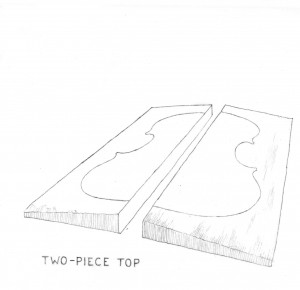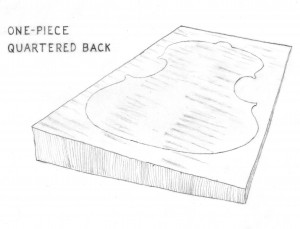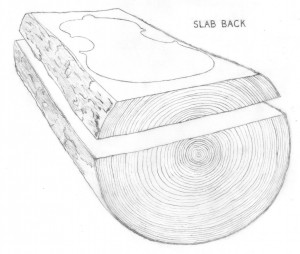The wood I use comes from only a few small areas of the world, has been carefully chosen and cut, and then sorted and culled, sorted and culled, until what I begin to make a violin with is literally a one-in-a-million piece of wood.
 There is much myth and lore about the secrets of the wood used in the great old Italian instruments. There are the “ponding” myths: that is, soaking the wood in various substances such as sheep dung, urine, or saltwater. There is the story that that great Venetian instruments were carved from the oars of the Venetian galleys. There is harvesting lore, saying that the woodcutter walked through the forest hitting the trees with his axe, cutting down the ones that rang the most musically. When these explanations of the greatness of those old makers fail us, and don’t hold up to scrutiny, we resort to throwing up our hands and saying, “the wood was just different back then.”
There is much myth and lore about the secrets of the wood used in the great old Italian instruments. There are the “ponding” myths: that is, soaking the wood in various substances such as sheep dung, urine, or saltwater. There is the story that that great Venetian instruments were carved from the oars of the Venetian galleys. There is harvesting lore, saying that the woodcutter walked through the forest hitting the trees with his axe, cutting down the ones that rang the most musically. When these explanations of the greatness of those old makers fail us, and don’t hold up to scrutiny, we resort to throwing up our hands and saying, “the wood was just different back then.”
Over the last half-century, all of these stories and ideas have been researched, experimented with, and scientifically analyzed. They have been found to have no substance by the majority of the world’s makers, researchers, and violin experts. In fact, through the fairly recent science of dendrochronology (a study of tree rings), it has been discovered that many of the greatest old Italian instruments were made with very freshly cut wood — the same year as they were made — and manifestly not treated in any way.
What these great makers had were not secrets or tricks, but a deep knowledge of wood, a generation-after-generation empirical experience of wood in all its subtlety and variation, and an ability to see with all their senses and pick just the right piece for the task at hand.
When my wood dealer pulls up to my studio in his van full of wood, I know I am in for a long day of hard choices, sorting through every piece of wood, looking for that perfect diamond in a field of lesser gems I am looking for lightness with strength, good grain orientation, and character, color, feel, sparkle, and life. Good wood is very expensive; deciding whether to buy a piece or let it go can be agonizing. But eventually I make my wood choices and carry the newly purchased wood up the ladder to my wood loft, leaving it to slowly age and await its day of transformation.
Wood for violin, viola, and cello tops is always spruce, and nearly always two pieces, having a glue joint down the center. The wood comes out of the tree in a split wedge, rather like a piece of firewood.
 This wedge is then cut down the middle, opened up like a book, and glued. The resulting top is therefore “quartered,” meaning the wood grains are perpendicular to the plane of the ribs. This is the strongest and most stable orientation. It is also “book-matched,” meaning it is more or less symmetrical from side to side.
This wedge is then cut down the middle, opened up like a book, and glued. The resulting top is therefore “quartered,” meaning the wood grains are perpendicular to the plane of the ribs. This is the strongest and most stable orientation. It is also “book-matched,” meaning it is more or less symmetrical from side to side.


